
The Silk Road Excursion (Part One): Xi’an
Since around the time of the Han Dynasty (about 200 BCE), the Silk Road connected the East and the West, facilitating the exchange of countless items as well as ideas between cultures. Travelers from both sides of the world used this route in order to get their hands on exotic goods, such as spices and, of course, silk.
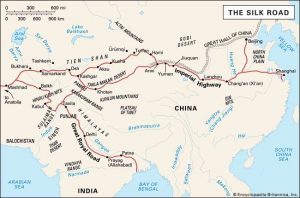
We traveled along this same Silk Road. The journey took us over 2,000 miles west, and along the way, we experienced quite a different China, a China that was significantly more diverse, rich, and complex than I had originally thought.
It’s difficult to put the awe and wonder that I felt throughout the trip into comprehensible words. Even as I write this blog, I have to pause every once in awhile to look at the pictures I took and find the right words to describe it all. This is where the phrase “you had to have been there” had to have come from. There was a presence that I felt at some of these historical, and even local, sites that cannot be neatly wrapped up with a bow. The trip left, for lack of a better, less cliche, word, an impact on me. The memories that I created and the emotions that I felt were so personally beautiful that I’ve been itching to digest them for quite some time. And now, through these words, I can unpack my amazing experience and share it with you all.
As a side note, I will be referencing our fondly nicknamed trip itinerary, the “Travel Bible,” which has amazing and detailed information about all of the locations that we visited, here and there, just to provide some background for you all.
All in all, the Silk Road excursion lasted for two weeks. As a brief summary, we first wandered around within the city walls of Xi’an, hiked up mountains and enjoyed Tibetan culture in Xia’he, ate some delicious hand-pulled noodled in Lanzhou, got caught in sandstorms and took selfies with camels in Dunhuang, explored some ancient city ruins in Turpan, and experienced Uyghur culture and bargaining within the bazaars and markets of Kashgar.
Since so many things happened in each city we visited, I will be dividing the Silk Road into a series of blogs, each describing our adventures in one city.
So let’s start with Xi’an.
Xi’an: Starting Point of the Silk Road and Home of the Terracotta Warriors
In the few days leading up to departure day, we spent our time buying last minute things and packing our bags. It’s an art to make sure that you bring just enough stuff to last you for two weeks but not too much stuff that you’re stuck lugging extra weight around for the entire trip. Personally, I brought two backpacks: one that had my clothes and toiletries, which I wore on my back, and one that had my important items, such as my passport and my wallet, which I wore in the front of me.
If you can imagine me waddling around with two stuffed backpacks like a penguin, you have the right idea of Justine on the road.
Our group consisted of the 29 students who make up TBC’s Fall 2018 student body plus 5 “trip leaders.” The trip leaders basically made sure we as a group didn’t fall into complete and utter chaos, but they were extremely good company. I became close with many of them through random shenanigans.
Our first destination was the city of Xi’an, known as Chang’an during the Tang dynasty. It had historically served as an ancient capital of China. The city had seen about 11 Chinese dynasties over a period of about 4,000 years. To get there, we took our first overnight train of the trip (the first of 5 trains).
Here in China, getting onto any sort of train, whether it be overnight or subway, requires you to go through security, and it’s something similar to airport security. I’m sure you’re quite familiar with the process: you put all of your bags through an x-ray machine, then you walk through that gate thing that you pray doesn’t beep when you walk through it even though you logically have nothing problematic on you, and then afterwards, it’s a mad scramble to grab all of your things so you’re not the one holding up the entire line.
But anyways, all 35 of us headed to our designated waiting room once we passed security. We followed one of the trip leaders who held up the iconic red TBC flag so we wouldn’t lose track of the group’s location. Holding the flag was jokingly called the most powerful thing to be wielded throughout the trip, and the person who held it had unlimited power because they decided the group’s fate. If one of the students happened to get ahold of it, even for a few minutes, it was the most universe-exploding thing ever.
In the waiting room, where our “departure gate” was located, we plopped all of our stuff in the middle of an aisle in-between waiting seats, since all of them were already taken. You can imagine the look on some of the Chinese natives’ faces when they saw a huge group of foreigners just chilling out around a fortress of backpacks and suitcases. Multiple times throughout the trip, whenever we would pull out a deck of cards to pass the time, it wasn’t unusual for us to have some curious Chinese folks watching us play card games.

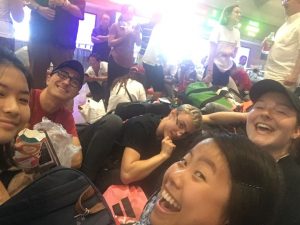
After a few hours of waiting, we boarded our first overnight train. It was the first time any of us students had gotten on an overnight train, and luckily, our first experience was quite pleasant. Most of everyone was in the same train cart, and all of the beds were freshly made. The layout of the cart was rows of three beds stacked on top of each other on one side with one small hallway on the other side. The first overnight train bed I slept in was the middle bunk, so I had to climb up a ladder to get into my bed. I remember most of that night was spent talking to the people in my row before all of us knocked out for the rest of the 11 hours of the train ride.
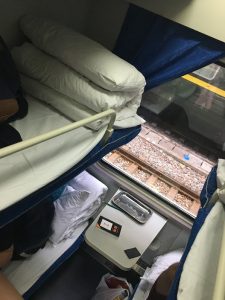

Our train arrived in Xi’an early the next morning. My first impression of the city was that it was beautiful. Unlike most city walls in China, Xi’an’s 9-mile long, rectangular city walls still exist, and as we walked around the city that early morning, groggy from the overnight train, those walls were a sight to behold. The sun seemed to greet us as it rose higher and higher in the sky.
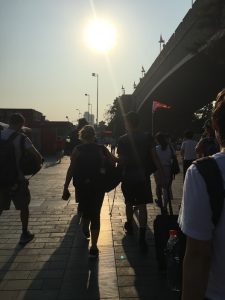
We met up with our first tour guides of the excursion, two very sweet local women named Julie and Sophia, who led us to our hotel. After briefly dropping our stuff off at the hotel, we hopped onto our bus and were driven to see our first sight-seeing destination: the Terracotta Warriors Museum.
To briefly explain, the Terracotta Warriors, an army of over 7,000 life-sized clay soldiers, archers, and horses, were made to protect the tomb of a Chinese emperor, Qin Shi Huang. They were discovered by peasants digging a well in 1974, and a total of 3 “pits” were found, the first one being the most popular because it holds over 8,000 soldiers, all standing in battle formation. The warriors, being made out of clay, had been found in pieces, but over the years, scientists worked diligently to piece them together and arrange them in the pits the way they had been buried all of those years ago. If I remember correctly, Sophia told us that only about 25% of all the warriors have been successfully put back together.
Yeah, 75% of the Terracotta Warriors aren’t put back together yet.
The moment we were released to explore that first pit, we got a firsthand account of how popular it was because there was probably hundreds of people trying to wrestle their way to the front of the balcony in order to get the best view of all of the warriors. If there is anything good about being small, it’s that you’re able to wrestle and squirm your way through crowds pretty easily. In this case, it allowed for me to get the best view of all of those Terracotta Warriors.

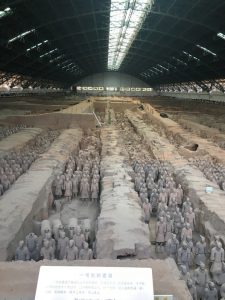
Let me tell you, to see all 8,000+ statues standing in line and staring back at you blankly in person was something else. The pictures I took can only mimic the chilling feeling of all of those eyes staring at you. It felt like they all, at any time, could take a step forward towards us. The sheer number of them was enough to be taken aback, but the fact that they all were so realistic made it that much more impactful (every warrior had been sculpted after an actual soldier in the Qin Shi Huang’s army). It looked like that even thousands of years after they were built for their emperor, they were still ready to fight for him.
The second pit had statues in glass boxes so we could get a closer look at them. Before they were buried, the Terracotta Warriors were painted, but upon excavation, exposure to oxygen made the paint oxidize and fade away, leaving the warriors to pale brown color that they are today. But one on display in second pit still had some remnants of paint on him, and my mind wandered at the thought of how he could have looked like if he still was fully painted.
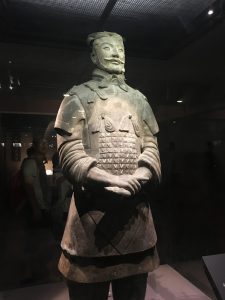
After the Terracotta Warriors and recuperating in our hotel rooms for a bit, we walked over to the Big Mosque, one of the largest mosques in China. I wasn’t so sure what I was expecting for a mosque in China, but I was pleasantly surprised at the amount of Chinese-styled architecture in the buildings. They were elegant and very much Chinese-styled, yet they are still used to this day to practice Islam. We were given a tour and a fascinating lecture on the history of the mosque.
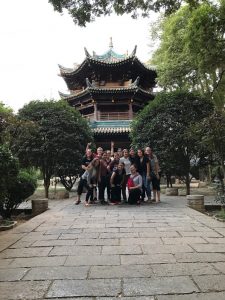
Then, we were given free time for dinner. My friends and I, after wandering around in a street filled with stores selling all kinds of trinkets at a bargain-able price, instantly decided to get some street food along Muslim Street. We had walked past it on the way to the Big Mosque, and our curiosity just couldn’t be contained.

Muslim Street was filled with food stalls and stores and brilliantly lit up colorful lights, and it was crowded with hungry people trying to get tasty cheap treats for dinner. I remember the addicting smell of roasted meats and spices and the enthusiastic yells of street vendors. Usually, the food was prepared right in front of you — I vividly remember the hanging meat carcasses and cooks carving meat right off of them before throwing them on a grill. My friends and I managed to get our hands on some that meat grilled to perfection on a stick (like an actual wood stick) and this fried crispy bun that was filled with meat and onions. While we waited for our meat buns, we watched as chefs rolled and folded the dough with their experienced, fast hands, and then flatten them before putting them in a large fryer. The exterior was light and crispy, while the inside was bursting with meat-y and onion-y flavor. The filling just melted in your mouth. It was the best thing I put into my mouth that night. The best part was, I seem to recall that it was less than a dollar. In fact, most of the food that we got was all less than a dollar.
I wish we could have eaten there every night…
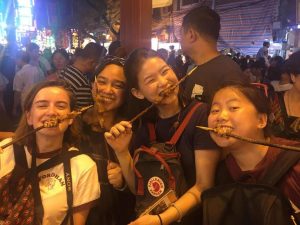
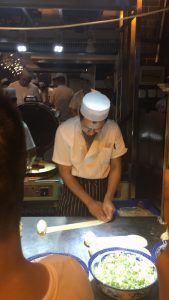

With full bellies, we wandered back to our hotel, enjoying the lit up pagodas and streets. I remember the night air being very comfortable, and I remember thinking how much we had already done in the first two days of the trip. Needless to say, we slept very well that night.
The next day, we were given a choice in activities: we could either bike along the top of the city walls or we could walk over and explore the Forest of Steles. Because I would rather eat ice cream than become ice cream in the heat and humidity of the day, I chose to go to the Forest of Steles.
The Forest of Steles is a museum that houses over 1,000 steles, or stone pillars that are carved for commemorative purposes. Most of them are carved with the teachings of Confucius, a Chinese scholar whose teachings became what is now known as Confucianism. Some of the steles were able to be touched, and I marveled in awe at these ancient pillars as I traced my fingers along some of the characters etched in the stone. I was even able to recognize some of the characters from my knowledge from studying Japanese. My friends and I wondered out loud what the carvings said and how Confucian scholars were able to carve characters into stone so beautifully many times. In addition to the many steles, there was a special exhibition that showcased Buddha and bodhisattva statues amongst other Buddhist items, which was interesting to look at as someone who comes from a Buddhist family.
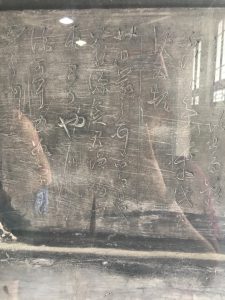
After leaving the Forest of Steles and grabbing some lunch on our own, we regrouped with the people who had went biking and were driven to a museum dedicated to the Silk Road, where we were given a tour by one of the staff. There, we saw original coins used by merchants to trade on the Silk Road as well as some discovered goods that are thought to have been traded along the route. We even saw the original preserved ground that still had tracks of the carts that came to Xi’an all those years ago.

To put this into perspective, the Silk Road is thought to have started around 200 BCE, and this museum still had the imprints of the wheels of merchants’ carts from that long ago.
How cool is that?
Even now I can’t really grasp at how ancient the things I saw in Xi’an were. Looking at the imprints on the ground, I could just imagine the merchants coming into Xi’an to start their journey on the Silk Road. It just really made me put what I knew in perspective. The United States, based on when the Declaration of Independence was signed, is only about less than 250 years old — the Terracotta Warriors were built over 2,000 years ago. The Big Mosque that we visited was built in 742, more than 1,000 years ago.
Isn’t that just amazing?
But before I could even process all of that, we had to hop onto another overnight train to get to our next destinations: Xia’he and Lanzhou.
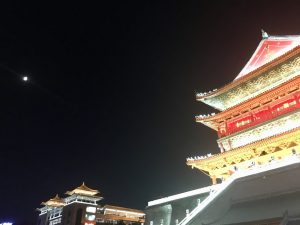
Come back next time to hear about it!
Until next time~
-Justine